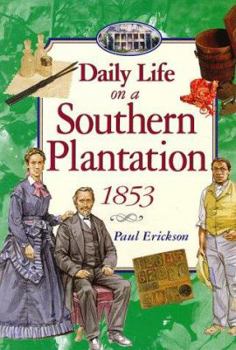Daily Life on a Southern Plantation 1853
Select Format
Select Condition 
Book Overview
Owners and slaves: two views of plantation lifeIn this handsome book, you will meet the Hendersons, who live on a Southern plantation with their children in 1853. You'll also meet Daddy Major, Rosena, Scipio, and Cicero, slaves who work in the Big House and in the cotton fields. Full-color photographs of interiors, clothing, and objects, plus artwork and oral history, document a typical day on a plantation. You will see the stately bedrooms and dining...
Format:Hardcover
Language:English
ISBN:0525675477
ISBN13:9780525675471
Release Date:February 1998
Publisher:Dutton Books
Length:48 Pages
Weight:1.29 lbs.
Dimensions:0.4" x 9.6" x 12.7"
Age Range:10 years and up
Grade Range:Grade 5
Customer Reviews
4 ratings
The daily life of all members of a southern slaveholding plantation
Published by Thriftbooks.com User , 17 years ago
Slavery as it existed in the American south before the Civil War ended it was indeed a "peculiar institution." While there were some southerners who understood that it would end soon, most slaveholding whites considered it the natural order of things. Some of that was simple social inertia, as it is always difficult to change deep-rooted structures. However, a large part of it was economic, slaves were valuable commodities, worth thousands of dollars each. This book describes the typical day on a slaveholding plantation, starting from the first light of dawn. The descriptions are based on the seasons and the days of the week. For example, when the early morning is described, the differences in the actions of the field slaves, stable slaves, house slaves and owners are described. How their actions differ during the days of the week is also mentioned. As the day progresses, we are taken through their lives and routines. From the descriptions, one can see how the slaveholding whites would want that routine to continue and how the thought of all blacks being free terrified them. For deep down, they understood that theirs was a lifestyle that could not continue for much longer. One of the key points, and one that would have eventually doomed slavery, is that finished goods such as metal tools and household utensils were no longer made on the plantations. They were made elsewhere, almost always in Northern or European factories. The Southern economy was based almost totally on agriculture and slave labor, something that would have doomed the South eventually. In fact some historians have argued that had the war not broken out when it did, slavery would probably not have survived another ten years. This "day" in the life of all the members of a slaveholding plantation shows us how they lived and if you read closely, you can see the seeds of how slavery would have ended. If it had not ended in a brutal war, it would have ended via class struggle within a short time.
Daily Life in a Southern PLantation 1853
Published by Thriftbooks.com User , 18 years ago
This book was very informative and interesting. Great for kids in school.
Beautifully Done!
Published by Thriftbooks.com User , 22 years ago
Picked up this book at Frogmore Plantation in Louisiana (A living history and modern cotton plantation--check out frogmoreplantation. com!) for some young friends. It's a fascinating peek into plantation life in the 1850's. Highly recommended for children and adults alike.
Excellent, interesting and accurate!
Published by Thriftbooks.com User , 24 years ago
This book really makes history interesting. We recognized many of the photos from a former plantation in our home town. I'd recommend it to both adults and children - it's well written (and researched) and has good photos.







